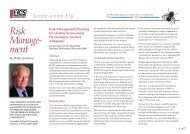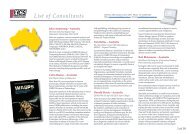Manual for Diagnosis of Screw-worm Fly - xcs consulting
Manual for Diagnosis of Screw-worm Fly - xcs consulting
Manual for Diagnosis of Screw-worm Fly - xcs consulting
Create successful ePaper yourself
Turn your PDF publications into a flip-book with our unique Google optimized e-Paper software.
Hydrocarbon content (Table 1)<br />
Chrysomya bezziana<br />
The cuticular hydrocarbons <strong>of</strong> newly emerged C. bezziana comprise mainly saturates with<br />
carbon chain lengths <strong>of</strong> ca 25 to 37. The largest components are 2-methyloctacosane (ECL=<br />
28.64); internal-methylnonacosane (i-methylnonacosane, 29.33); 2-methyltriacontane (30.64);<br />
i-methylhentriacontane (31.31); and i-methyl- and dimethyl-tritricontane (33.31 and 33.57).<br />
Males and females have identical pr<strong>of</strong>iles. Between emergence and day 5, quantitative<br />
changes in cuticular hydrocarbon composition occur; these are more pronounced <strong>for</strong> females<br />
than males. From day 5 the pr<strong>of</strong>iles stabilise again. The percentages <strong>of</strong> several components,<br />
mainly those with carbon chain lengths greater than 34, increase while those <strong>of</strong> other<br />
components decrease. Values <strong>for</strong> major components are given in the Table <strong>for</strong> newlyemerged<br />
and 5 day old flies. Flies <strong>of</strong> intermediate ages have hydrocarbon compositions<br />
between those <strong>of</strong> these two stages.<br />
Chrysomya megacephala<br />
Young C. megacephala flies also contain hydrocarbons which are predominantly alkanes,<br />
but mainly <strong>of</strong> shorter chain lengths than those <strong>of</strong> C. bezziana. The two largest components<br />
are i-methylheptacosane (27.33) and 2-methyloctacosane (28.64). Other major components<br />
include n-heptacosane (27.00), n-nonacosane (29.00) and i-methylnonacosane (29.33). The<br />
most abundant alkanes are heptacosene and nonacosene (26.79 and 28.81, 2-3%). Cuticular<br />
hydrocarbon data <strong>for</strong> older flies are not available.<br />
Chrysomya saffranea<br />
C. saffranea contains hydrocarbons very similar to those <strong>of</strong> C. megacephala. The mean<br />
value <strong>of</strong> heptacosene (26.79) in females is higher, but this component is very variable and<br />
some individuals have levels comparable with those <strong>of</strong> C. megacephala. Again cuticular<br />
hydrocarbon data <strong>for</strong> older flies are not available.<br />
Cochliomyia hominivorax<br />
Agriculture, Fisheries and Forestry - Australia<br />
The cuticular hydrocarbons <strong>of</strong> newly-emerged male and female Co. hominivorax are<br />
dominated by those with a C29 carbon chain, particularly i-methylnonacosane (29.33).<br />
2-methyloctacosane (28.64) is also abundant but all other components are quite minor.<br />
The hydrocarbon composition <strong>of</strong> this species changes much more with age and sex than<br />
does that <strong>of</strong> C. bezziana (see Pomonis 1989). By day 5, males have aquired large quantities<br />
<strong>of</strong> n- and i-methylpentacosane and heptacosane and have lost most <strong>of</strong> the i-methyl- and<br />
3-methylnonacosane. Females also acquire n- and i-methylheptacosane (but not<br />
pentacosane) as well as increasing the proportions <strong>of</strong> longer chain length material (greater<br />
than C30).<br />
49




